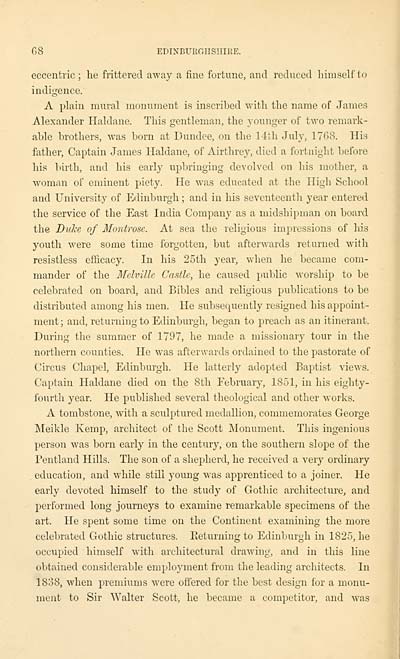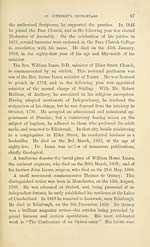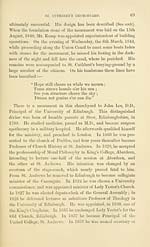Grampian Club > Monuments and monumental inscriptions in Scotland > Volume 1
(92) Page 68
Download files
Complete book:
Individual page:
Thumbnail gallery: Grid view | List view

68 EDINBURGHSIIIIJE.
eccentric ; he frittered away a fine fortune, and reduced himself to
indigence.
A plain mural monument is inscribed witli the name of James
Alexander Haldane. This gentleman, the younger of two remark-
able brothers, was born at Dundee, on the 14lh July, 1768. His
father, Captain James Haldane, of Airthrey, died a fortnight before
his birth, and his early upbringing devolved on his mother, a
woman of eminent piety. He was educated at the High School
and University of Edinburgh ; and in his seventeenth year entered
the service of the East India Company as a midshipman on board
the Duke of Montrose. At sea the religious impressions of lus
youth were some time forgotten, but afterwards returned with
resistless efficacy. In his 25th year, when he became com-
mander of the Melville Castle, he caused public worship to be
celebrated on board, and Bibles and religious publications to be
distributed among his men. He subsequently resigned his appoint-
ment ; and, returning to Edinburgh, began to preach as an itinerant.
During the summer of 1797, he made a missionary tour in the
northern counties. He was afterwards ordained to the pastorate of
Circus Chapel, Edinburgh. He latterly adopted Baptist views.
Captain Haldane died on the 8th February, 1851, in his eighty-
fourth year. He published several theological and other works.
A tombstone, with a sculptured medallion, connnemorates George
Meikle Kemp, architect of the Scott Monument. This ingenious
person was born early in the century, on the southern slope of the
Pentland Hills. The son of a shepherd, he received a very ordinary
education, and while still young was apprenticed to a joiner. He
early devoted himself to the study of Gothic architecture, and
performed long journeys to examine remarkable specimens of the
art. He spent some time on the Continent examining the more
celebrated Gothic structures. Eeturning to Edinburgh in 1825, he
occupied himself wdth architectural drawing, and in this line
obtained considerable employment from the leading architects. In
1838, when premiums were offered for the best design for a monu-
ment to Sir Walter Scott, he became a competitor, and was
eccentric ; he frittered away a fine fortune, and reduced himself to
indigence.
A plain mural monument is inscribed witli the name of James
Alexander Haldane. This gentleman, the younger of two remark-
able brothers, was born at Dundee, on the 14lh July, 1768. His
father, Captain James Haldane, of Airthrey, died a fortnight before
his birth, and his early upbringing devolved on his mother, a
woman of eminent piety. He was educated at the High School
and University of Edinburgh ; and in his seventeenth year entered
the service of the East India Company as a midshipman on board
the Duke of Montrose. At sea the religious impressions of lus
youth were some time forgotten, but afterwards returned with
resistless efficacy. In his 25th year, when he became com-
mander of the Melville Castle, he caused public worship to be
celebrated on board, and Bibles and religious publications to be
distributed among his men. He subsequently resigned his appoint-
ment ; and, returning to Edinburgh, began to preach as an itinerant.
During the summer of 1797, he made a missionary tour in the
northern counties. He was afterwards ordained to the pastorate of
Circus Chapel, Edinburgh. He latterly adopted Baptist views.
Captain Haldane died on the 8th February, 1851, in his eighty-
fourth year. He published several theological and other works.
A tombstone, with a sculptured medallion, connnemorates George
Meikle Kemp, architect of the Scott Monument. This ingenious
person was born early in the century, on the southern slope of the
Pentland Hills. The son of a shepherd, he received a very ordinary
education, and while still young was apprenticed to a joiner. He
early devoted himself to the study of Gothic architecture, and
performed long journeys to examine remarkable specimens of the
art. He spent some time on the Continent examining the more
celebrated Gothic structures. Eeturning to Edinburgh in 1825, he
occupied himself wdth architectural drawing, and in this line
obtained considerable employment from the leading architects. In
1838, when premiums were offered for the best design for a monu-
ment to Sir Walter Scott, he became a competitor, and was
Set display mode to: Large image | Transcription
Images and transcriptions on this page, including medium image downloads, may be used under the Creative Commons Attribution 4.0 International Licence unless otherwise stated. ![]()
| Publications by Scottish clubs > Grampian Club > Monuments and monumental inscriptions in Scotland > Volume 1 > (92) Page 68 |
|---|
| Permanent URL | https://digital.nls.uk/80691533 |
|---|
| Description | Vol. I. |
|---|---|
| Attribution and copyright: |
|
| Description | Note: Numbers 24-41 are relative to but not part of the Club's series. |
|---|---|

